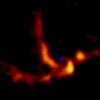| Jets: Numerical Model | ||||||||||
|
Abstract The instabilities of astrophysical jets are investigated in a new and more generalized way than in previous studies. The dispersion equations for a thermal confined slab jet in a complex (k, omega) domain are solved. A number of singularities related to certain wave modes in this system are found. It is shown that the internal jet flow in the system is characterized by two internal sound waves, propagating against and with the flow, respectively. These two body waves grow in amplitude. The one propagating against the flow is condensed, which is crucial to disruption of jets. The other, propagating with the flow, is rarefied and less important in jet disruption. There are also a number of surface waves existing in the interface between the jet flow and the ambient medium. Two of them are identified to couple to their relevant acoustic body waves. They also grow in amplitude. It is suggested that the growing internal body waves and abundant growing surface waves can potentially explain many phenomena observed in astrophysical jets, such as quasi-periodic wiggles, jet disruption, limb-brightened features, and surface filaments.
Abstract Numerical simulations of an unstable supersonic slab-symmetric jet are described. The instabilities within the jet are characterized by growing internal body waves and their coupled surface waves that are also predicted in linear perturbation theory. The characteristic theory of fluid dynamics is used to help interpret the wave morphologies. It is demonstrated that these waves can be excited by imposing an arbitrary disturbance. From the numerical simulations, it is found that the sound waves propagating against the flow slow down as they propagate outward, and they grow in amplitude. These waves eventually disrupt the jet at a certain length. This disruption length is related to the jet Mach number and the perturbation intensity. Thus, the Mach number of a jet observed with a radio telescope can be estimated by measuring the disruption length and estimating the perturbation intensity. The jet Mach numbers in radio tailed sources determined in this way agree quite well with estimates from ram pressure bending arguments. The wiggles and flares observed in many extragalactic jets, especially in tailed radio sources, appear to be intimately related to instabilities and the jet disruption process.
| ||||||||||







